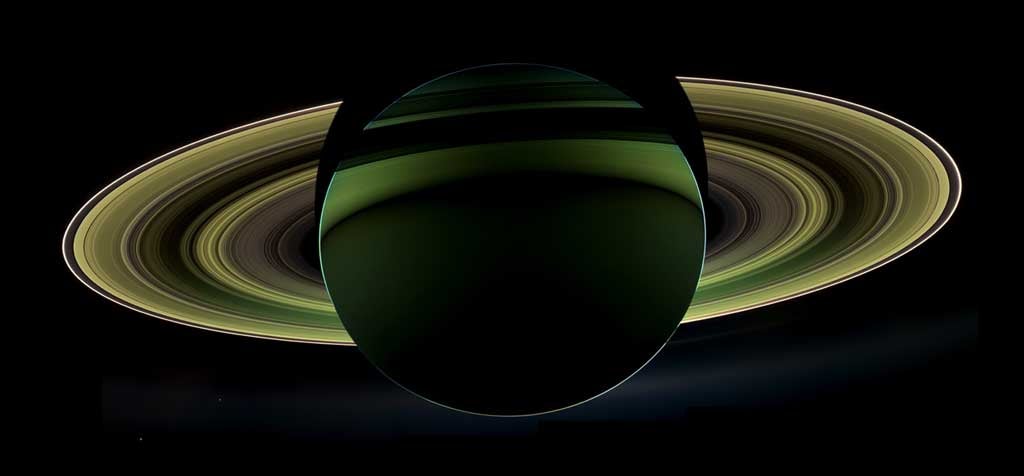On October 17, 2012, during its 174th orbit around the gas giant, Cassini was deliberately positioned within Saturn’s shadow, a perfect location from which to look in the direction of the Sun and take a backlit view of the rings and the dark side of the planet. Looking back toward the Sun is a geometry referred to by planetary scientists as “high solar phase” — near the center of the target’s shadow is the highest phase possible. This is a scientifically advantageous and coveted viewing position as it can reveal details about both the rings and atmosphere that cannot be seen in lower solar phase.
The last time Cassini had such an unusual perspective on Saturn and its rings, at sufficient distance and with sufficient time to make a full system mosaic, occurred in September 2006 when it captured a mosaic, processed to look like natural color, entitled “In Saturn’s Shadow-The Pale Blue Dot.” In that mosaic, planet Earth put in a special appearance, making “In Saturn’s Shadow” one of the most popular Cassini images to date.
The mosaic being released today by the mission and the imaging team does not contain Earth — along with the Sun, our planet is hidden behind Saturn. However, it was taken when Cassini was closer to Saturn and therefore shows more detail in the rings than the one taken in 2006.
“Of all the many glorious images we have received from Saturn, none are more strikingly unusual than those taken from Saturn’s shadow,” said Carolyn Porco, Cassini’s imaging team lead based at the Space Science Institute in Boulder, Colorado. “They unveil a rare splendor seldom seen anywhere else in our solar system.”
On October 17, 2012, during its 174th orbit around the gas giant, Cassini was deliberately positioned within Saturn’s shadow, a perfect location from which to look in the direction of the Sun and take a backlit view of the rings and the dark side of the planet. Looking back toward the Sun is a geometry referred to by planetary scientists as “high solar phase” — near the center of the target’s shadow is the highest phase possible. This is a scientifically advantageous and coveted viewing position as it can reveal details about both the rings and atmosphere that cannot be seen in lower solar phase.
The last time Cassini had such an unusual perspective on Saturn and its rings, at sufficient distance and with sufficient time to make a full system mosaic, occurred in September 2006 when it captured a mosaic, processed to look like natural color, entitled “In Saturn’s Shadow-The Pale Blue Dot.” In that mosaic, planet Earth put in a special appearance, making “In Saturn’s Shadow” one of the most popular Cassini images to date.
The mosaic being released today by the mission and the imaging team does not contain Earth — along with the Sun, our planet is hidden behind Saturn. However, it was taken when Cassini was closer to Saturn and therefore shows more detail in the rings than the one taken in 2006.
“Of all the many glorious images we have received from Saturn, none are more strikingly unusual than those taken from Saturn’s shadow,” said Carolyn Porco, Cassini’s imaging team lead based at the Space Science Institute in Boulder, Colorado. “They unveil a rare splendor seldom seen anywhere else in our solar system.”










